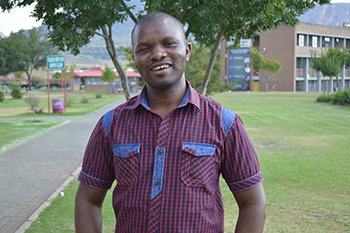Academics should strive to work with students towards publishing, says NRF-rated researcher

Dr Rodwell Makombe, Y-gegradeerde navorser.
Foto: Thabo Kessah
“The National Research Foundation (NRF) is a prestigious research institution and to be recognised by such an institution means that my work is worthwhile. This alone motivates me to do more research.” This is how Dr Rodwell Makombe reflected on his recent recognition as an NRF-rated researcher – one of the few on the Qwaqwa Campus. He is a Senior Lecturer in the Department of English at the University of the Free State’s Qwaqwa Campus.
“This recognition is indeed an important milestone in my research career. It means that my efforts as a researcher are recognised and appreciated. The financial research incentive will enable me to engage in more research, attend conferences, and so forth,” he said.
Comparing research in the Humanities and Sciences
Dr Makombe’s research area is broadly postcolonial African literature, but he is particularly interested in postcolonial literatures and resistance cultures. He is currently working on a book project entitled Visual Cultures of the Afromontane.
When asked what he thought about Natural Sciences being in the lead as far as research is concerned, he said that this is mainly caused by funding opportunities.
“It means that my efforts as a
researcher are recognised and
appreciated.”
“It is easier to access funding for research in the Natural Sciences than for the Humanities. Researchers in the Humanities usually do research without any form of funding. However, there are also differences in the way research is done in the Sciences than in the Humanities. Science researchers tend to work together on different projects, which make it easier for them to have their names on publications, no matter how small their contribution. This is also connected to the issue of funding,” he added.
He continued: “Since research in the Humanities is largely unfunded, it is difficult for researchers to establish research groups. Another issue is that most academics in the Humanities do not necessarily teach modules within their research interests. Therefore, they tend to be overloaded with work as they have to do research in one area and teach in another area.”
NRF-rating and funding
For Dr Makombe, the solution to this challenge lies in academics in the Humanities working towards publishing with their students. “This way,” he said, “both the students and the academics will get publications that will help them to get NRF-rating and other forms of research funding. Modules in the Humanities need to be aligned to academics’ research interests to avoid mismatches between teaching and research.”
He previously worked at the University of Fort Hare and the Durban University of Technology and has published several articles in both local and international journals.